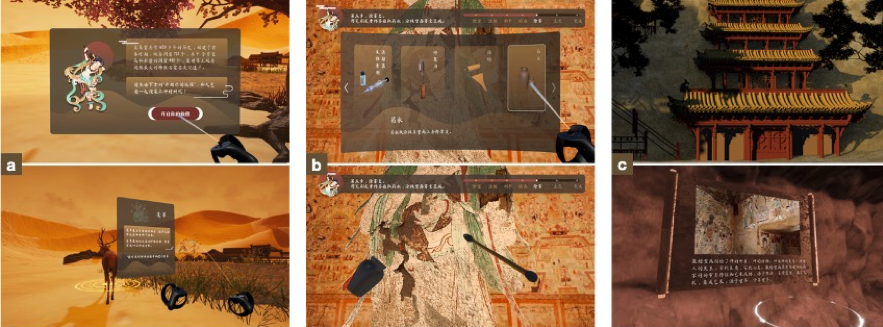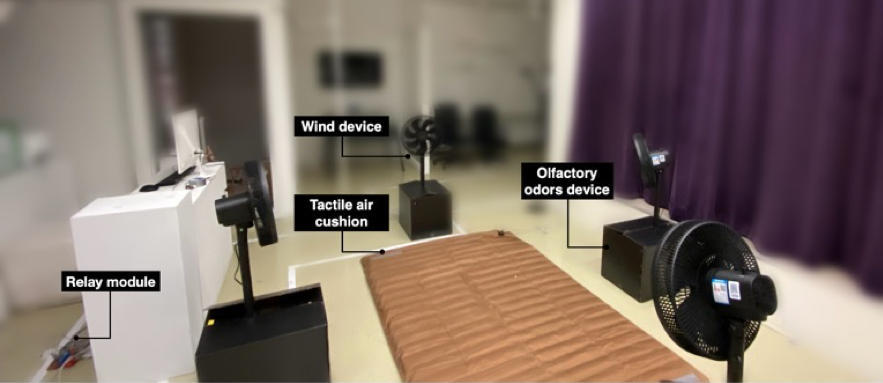The video of the entire VR gaming process
A participant experiencing the mural restoration.



DunHuang Murals VR Restoring
Immersive Virtual Reality experiment for
Cultural Heritage Preservation
The paper Restoring Dunhuang Murals: Crafting Cultural Heritage Preservation Knowledge into Immersive Virtual Reality Experience Design to which this experiment belongs has been accepted by IJHCI.
The IVR application was developed by me with Unreal Engine version 4.27, which supported lossless import of 3D models from C4D, high-quality 3D rendering, dynamic simulation of natural environmental light sources, and flexible Blueprint Visual Scripting system. The spatial scene is the basis of the IVE system. After importing the C4D model, I adjusted and processed the 3D model through some basic options of the rendering engine, such as meshes, materials, shaders, and behavior trees, so that the visual effects of the spatial environment and objects are consistent and harmonious . At the same time, I designed the guidancepath and interactive behaviors of the nine-colored deer through the behavior tree, such as turning head, eating grass, roaming, etc., so that it can naturally lead the user to complete the task of material collected in the desert scene. In addition, I used Real-Time Render Target Painting to achieve mural restoration and support users to freely create visual effects on the broken mural.
The background music for the desert scenes was composed using the Yayue Heptachord, a traditional Chinese tuning system, which is commonly used in ancient rituals and ceremonies, thus setting the emotional tone for the whole experience in the aural dimension and showing the religious and philosophical mood of Dunhuang culture. The orchestration was chosen to preserve the sense of solemnity and heaviness while cutting down on the low frequencies, while the middle and high frequencies were filled by the glockenspiel and harp with broken chords to create a light, fairy-tale feeling. The main vocal section alternated between cello, vocal and lute, symbolizing that "reverence- exploration-Humanistic care" was the emotional guide.
The background music orchestration of the restoration process is based on small hits, providing a quiet spatial atmosphere that allows the experience to focus on the restoration of the murals. The sound effect uses 44.1kHz/24bit high-precision sound material for scaling, the volume was adjusted, and some frequency bands are attenuated through the 3D spatialization function of Wwise middleware to achieve real-time changes in an interactive point coordinate sound effects and environmental sounds with the movement of the experience, thus enriching the details of the game process and enhancing the immersive sense of presence.
Immersive Virtual Reality experiment for
Cultural Heritage Preservation
The paper Restoring Dunhuang Murals: Crafting Cultural Heritage Preservation Knowledge into Immersive Virtual Reality Experience Design to which this experiment belongs has been accepted by IJHCI.
The IVR application was developed by me with Unreal Engine version 4.27, which supported lossless import of 3D models from C4D, high-quality 3D rendering, dynamic simulation of natural environmental light sources, and flexible Blueprint Visual Scripting system. The spatial scene is the basis of the IVE system. After importing the C4D model, I adjusted and processed the 3D model through some basic options of the rendering engine, such as meshes, materials, shaders, and behavior trees, so that the visual effects of the spatial environment and objects are consistent and harmonious . At the same time, I designed the guidancepath and interactive behaviors of the nine-colored deer through the behavior tree, such as turning head, eating grass, roaming, etc., so that it can naturally lead the user to complete the task of material collected in the desert scene. In addition, I used Real-Time Render Target Painting to achieve mural restoration and support users to freely create visual effects on the broken mural.
The background music for the desert scenes was composed using the Yayue Heptachord, a traditional Chinese tuning system, which is commonly used in ancient rituals and ceremonies, thus setting the emotional tone for the whole experience in the aural dimension and showing the religious and philosophical mood of Dunhuang culture. The orchestration was chosen to preserve the sense of solemnity and heaviness while cutting down on the low frequencies, while the middle and high frequencies were filled by the glockenspiel and harp with broken chords to create a light, fairy-tale feeling. The main vocal section alternated between cello, vocal and lute, symbolizing that "reverence- exploration-Humanistic care" was the emotional guide.
The background music orchestration of the restoration process is based on small hits, providing a quiet spatial atmosphere that allows the experience to focus on the restoration of the murals. The sound effect uses 44.1kHz/24bit high-precision sound material for scaling, the volume was adjusted, and some frequency bands are attenuated through the 3D spatialization function of Wwise middleware to achieve real-time changes in an interactive point coordinate sound effects and environmental sounds with the movement of the experience, thus enriching the details of the game process and enhancing the immersive sense of presence.